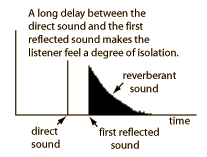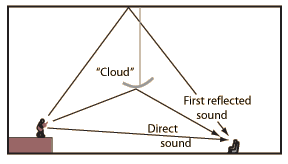Echoes in Auditoriums
The term echo in an auditorium refers to a reflected sound which stands out significantly over the normal reverberant sound of the auditorium. It is not sufficient in this context to just define an echo as a reflected sound, since the entire reverberant sound field is a collection of many reflected sounds. The term echo in auditorium acoustics may be the prominant reflection from a refective flat back wall, often called a 'slapback' echo.
Distracting echoes arise from focusing surfaces, which should therefore be avoided in auditoriums. In fact, it is good practice to include surfaces or structures which break up any large reflective surface. The columns, decorative woodwork, and general construction of the fine European music halls gives a good mix of reflected sound for more even dispersion of sound. Modern structures tend toward large smooth plaster or concrete surfaces which give problems with echoes.
|
Index
Auditorium acoustics |



